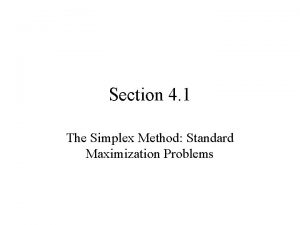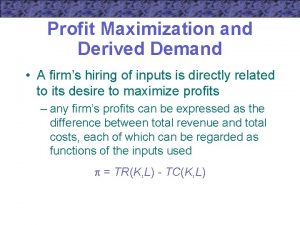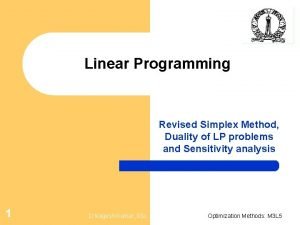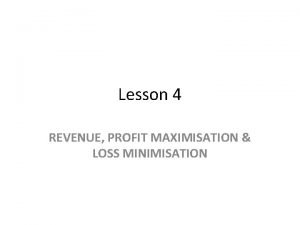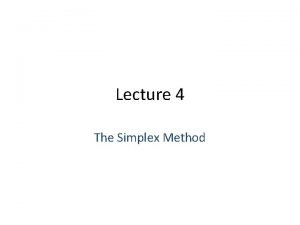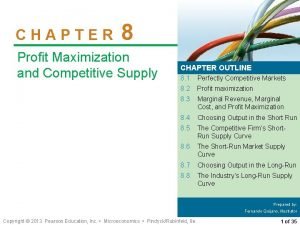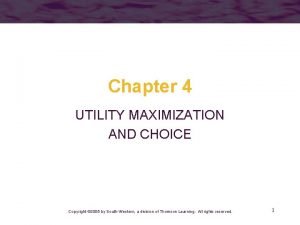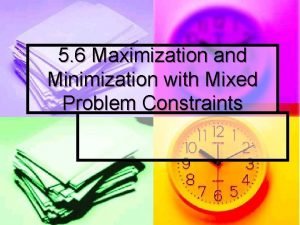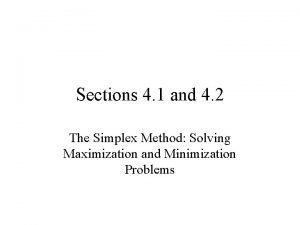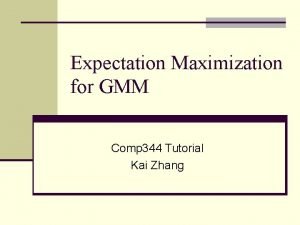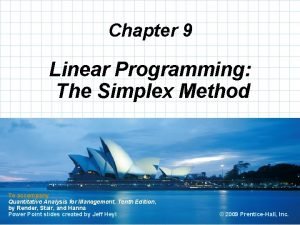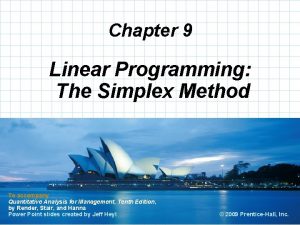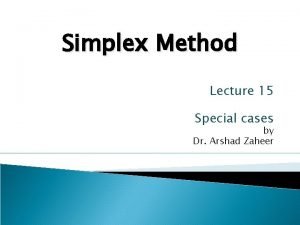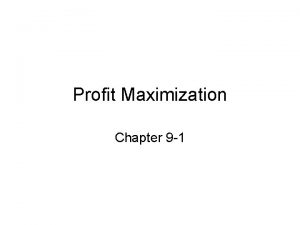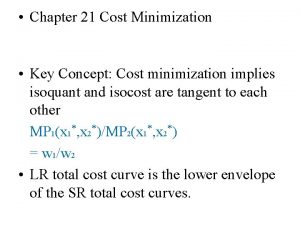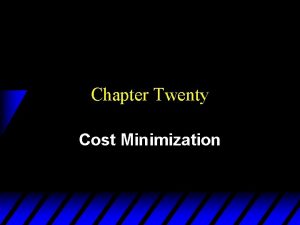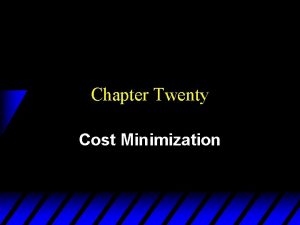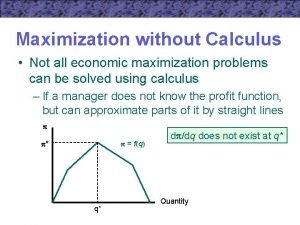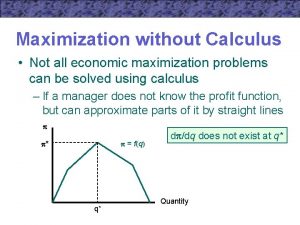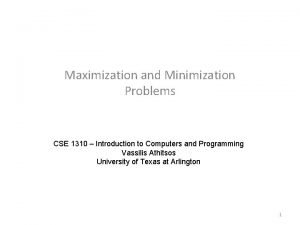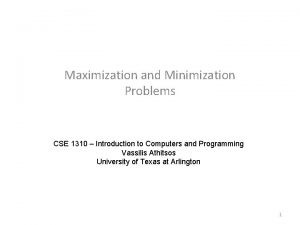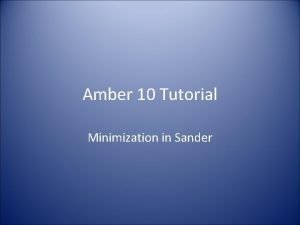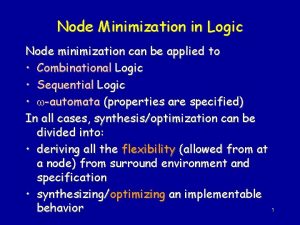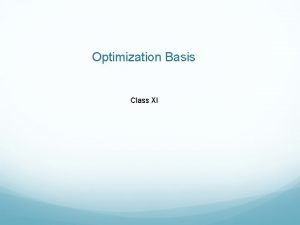Chapter 10 Minimization or Maximization of Functions Optimization























- Slides: 23

Chapter 10 Minimization or Maximization of Functions

Optimization Problems • Solution of equations can be formulated as an optimization problem, e. g. , density functional theory (DFT) in electronic structure, Lagrangian mechanics, etc • Minimization with constraints – operations research (linear programming, traveling salesman problem, etc), max entropy with a given energy, …

General Consideration • Use function values only, or use function values and its derivatives • Storage of O(N) or O(N 2) • With constraints or no constraints • Choice of methods

Local & Global Extremum

Bracketing and Search in 1 D c a b Bracket a minimum means that for given a < b < c, we have f(b) < f(a), and f(b) < f(c). There is a minimum in the interval (a, c).

How accurate can we locate a minimum? • Let b a minimum of function f(x), Taylor expanding around b, we have • The best we can do is when the second correction term reaches machine epsilon comparing to the function value, so

Golden Section Search x a b c • Choose x such that the ratio of intervals [a, b] to [b, c] is the same as [a, x] to [x, b]. Remove [a, x] if f[x] > f[b], or remove [b, c] if f[x] < f[b]. • The asymptotic limit of the ratio is the Golden mean


Parabolic Interpolation & Brent’s Method Brent’s method combines parabolic interpolation with Golden section search, with some complicated bookkeeping. See NR, page 404 -405 for details.

Minimization as a root-finding problem • Let’s derivative d. F(x)/dx = f(x), then minimizing (or maximizing) F is the same as finding zero of f, i. e. , f(x) = 0. • Newton method: approximate curve as a straight line.

Deriving Newton Iteration • Let the current value be xn and zero is approximately located at xn+1, using Taylor expansion • Solving for xn+1, we get

Convergence in Newton Iteration • Let x be the exact root, xi is the value in ith iteration, and εi =xi-x is the error, then • Rate of convergence: (Quadratic convergence)

Strategy in Higher Dimensions 1. Starting from a point P and a direction n, find the minimum on the line P + n, i. e. , do a 1 D minimization of y( )=f(P+ n) 2. Replace P by P + min n, choose another direction n’ and repeat step 1. The trick and variation of the algorithms are on chosen n.

Local Properties near Minimum • Let P be some point of interest which is at the origin x=0. Taylor expansion gives • Minimizing f is the same as solving the equation T for transpose of a matrix

Search along Coordinate Directions Search minimum along x direction, followed by search minimum along y direction, and so on. Such method takes a very large number of steps to converge. The curved loops represent f(x, y) = const.

Steepest Descent Search in the direction with the largest decrease, i. e. , n = - f n. T n’ = 0 n’ Constant f contour line (surface) is perpendicular to n, because df = dx f = 0. The current search direction n and next search direction are orthogonal, because for minimum we have y’( ) = df(P+ n)/d = n. T f|P+ n = 0 n

Conjugate Condition n 1 T A n 2 = 0 Make a linear coordinate transformation, such that contour is circular and (search) vectors are orthogonal

Conjugate Gradient Method 1. Start with steepest descent direction n 0 = g 0 = - f(x 0), find new minimum x 1 2. Build the next search direction n 1 from g 0 and g 1 = - f(x 1), such that n 0 A n 1 = 0 3. Repeat step 2 iteratively to find nj (a Gram-Schmidt orthogonalization process). The result is a set of N vectors (in N dimensions) ni. T A nj = 0

Conjugate Gradient Algorithm 1. Initialize n 0 = g 0 = - f(x 0), i = 0, 2. Find that minimizes f(xi+ ni), let xi+1 =xi+ ni 3. Compute new negative gradient gi+1 = - f(xi+1) (Fletcher-Reeves) 4. Compute 5. Update new search direction as ni+1 = gi+1 + ini; ++i, go to 2

The Conjugate Gradient Program

Simulated Annealing • To minimize f(x), we make random change to x by the following rule: • Set T a large value, decrease as we go • Metropolis algorithm: make local change from x to x’. If f decreases, accept the change, otherwise, accept only with a small probability r = exp[-(f(x’)-f(x))/T]. This is done by comparing r with a random number 0 < ξ < 1.

Traveling Salesman Problem Beijing Tokyo Shanghai Taipei Hong Kuala Lumpur Singapore Find shortest path that cycles through each city exactly once.

Problem set 7 1. 2. Suppose that the function is given by the quadratic form f=(1/2)x. T A x, where A is a symmetric and positive definite matrix. Find a linear transform to x so that in the new coordinate system, the function becomes f = (1/2)|y|2, y = Ux [i. e. , the contour is exactly circular or spherical]. More precisely, give a computational procedure for U. If two vectors in the new system are orthogonal, y 1 T y 2=0, what does it mean in the original system? We’ll discuss the conjugate gradient method in some more detail following the paper: http: //www. cs. cmu. edu/~quake-papers/painlessconjugate-gradient. pdf
 Standard maximization problem
Standard maximization problem Monopsony profit maximization
Monopsony profit maximization Limitations of profit maximization
Limitations of profit maximization Dual simplex method maximization problem
Dual simplex method maximization problem Profit maximization
Profit maximization Simplex
Simplex Normal profit economics
Normal profit economics Profit maximization and competitive supply
Profit maximization and competitive supply Cost revenue and profit maximization guided reading
Cost revenue and profit maximization guided reading Utility maximization problem
Utility maximization problem Perfect substitutes utility function
Perfect substitutes utility function Big m method minimization with mixed constraints
Big m method minimization with mixed constraints Kalkulator metode simpleks
Kalkulator metode simpleks Module 53 featured worksheet profit maximization
Module 53 featured worksheet profit maximization Profit maximization in financial management
Profit maximization in financial management Expectation maximization tutorial
Expectation maximization tutorial Customer lifetime value maximization
Customer lifetime value maximization Meaning of financial management
Meaning of financial management Abt model of social accounting
Abt model of social accounting The zj row in a simplex table for maximization represents
The zj row in a simplex table for maximization represents What cj-zj represents
What cj-zj represents Expectation maximization algorithm
Expectation maximization algorithm Unit 2 demand supply and consumer choice
Unit 2 demand supply and consumer choice Special cases in simplex method pdf
Special cases in simplex method pdf
